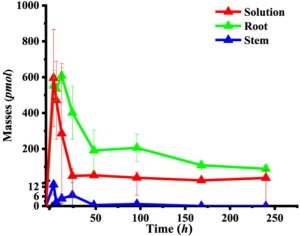A group from Research Center for Eco-Environmental Sciences, Chinese Academy of Sciences, Beijing, China, etc. has reported that plants detoxify Tetrabromobisphenol A (TBBPA) by glycosylation, but rhizobacteria deglycosylate it again.
https://www.ncbi.nlm.nih.gov/pmc/articles/PMC8603600/
TBBPA is among the most commonly used brominated flame retardants owing to its excellent properties and low price, and its annual application is continually increasing.
Plants can absorb TBBPA from water, soil, and air. Plants can transform various organic contaminants. The biotransformation of organic compounds in plants can be categorized into phase I, II, and III reactions according to the green liver concept of phytoremediation. For phenolic compounds that contain active hydroxyl groups, glycosylation is an important and common phase II reaction.
Glycosylated metabolites are generally more water soluble than parent contaminants and are therefore easily excreted from plant roots to the outside solutions. Some studies have reported that glycosylated metabolites can also be bound to cell walls and/or compartmentalized in special cell organelles, such as vacuoles. Thus, the formation of glycosylated metabolites can prevent contaminants from accumulation and translocation within plants, and they can decrease the toxic effects of the contaminants on plants.
In this work, the formation of glycosylated metabolites of TBBPA in pumpkin plants and their subsequent excretion from roots to hydroponic solutions effectively decreased the accumulation of TBBPA in plants. However, the deglycosylation of glycosylated metabolites mediated by the microorganisms back to their parent TBBPA revealed more complex uptake and biotransformation processes in these plant–microorganism systems. The TBBPA produced from the observed deglycosylation process can be then absorbed and cause adverse effects on plants and other soil organisms again.

